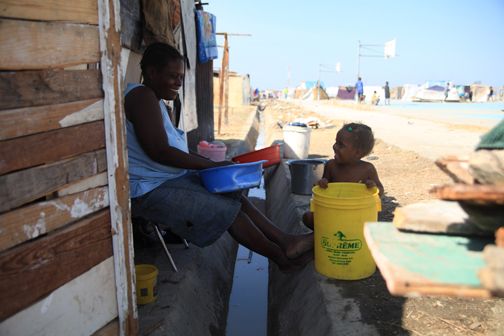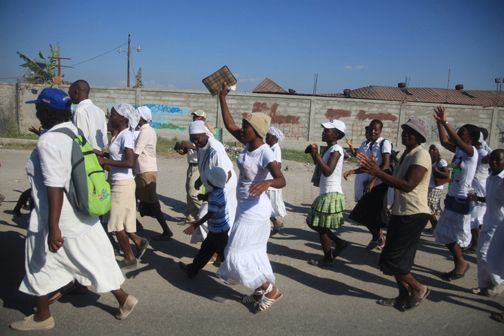The center of Port-au-Prince—its palace, ministries, schools and office buildings—lies in ruins. On January 12, the earth shook for less than a minute, but in those 35 seconds, buildings cracked and toppled, floors of concrete collapsing one atop the other, crushing hundreds of thousands of people as they fell.
In the evening light, the roads look like a scene from an apocalyptic movie. The streets are blocked by the twisted bodies of cars and endless mountains of rubble. Metal bars that were meant to help hold the buildings together are bent, defeated. Sheets of paper, pink and white and yellow, from what was once a seven-story office building, flit about in the smoke-filled air; the people, now living in shacks on the streets, are burning fires to cook their dinner. As we walk down a road a few blocks from Champs de Mars, the wind changes, so that the smell of smoke is mixed with that of death, of bodies buried beneath the destruction.
It's easy to look at all this, the devastated city, many of its people now living in parks, on sidewalks, on old airport runways—basically anywhere they can find flat land, and wonder how Haiti will ever recover. Though there are men with large yellow diggers trying to clear the rubble, they seem so small against the backdrop of broken buildings, their efforts appear so futile given the sheer magnitude of the work that must be done. And that's what we've seen on TV, these images of an already impoverished people dealt another unimaginably cruel blow by fate. Pundits talk primarily of the impossibility of the recovery; how can a people this poor, this uneducated, with a government this inefficient rebuild? How will they find their way, when the aid organizations and volunteers move on, when the people stop donating?
But as the world has focused on the hopelessness of it all, on the destruction, on the horrific images of the dead buried by the hundreds in mass graves, the Haitian people have gone on living. The men are still by the roadside, selling sugarcane, and the women sit, money buried in the lap folds of their dresses, pyramids of oranges for sale set before them.
On our first day in Haiti, we visited a vast settlement built on an old airport runway, appropriately named Sou Piste, meaning "on the runway," by its residents.
In the three weeks since the earthquake, about 40,000 people, most from slums like La Saline and Cite Soleil, have built a fully-functioning community here, where boys fly kites made of branches and stray plastic, girls fetch water from the pumps set up by the Red Cross, and men build and build and build, creating hundreds of new homes each day. For the most part, the people we spoke to had the same attitude about the earthquake—it happened; it destroyed their homes and killed their loved ones, took their limbs and in other ways damaged them, but they have to keep going. "What sense is there in just crying?" one woman asked me. "Crying cannot rebuild. Crying cannot make it better. We must keep working to make things better for ourselves."
And this is what strikes me most about Haiti—people's resilience in the face of immense tragedy. The story for me here is not one of poverty, of pity, of catastrophe, it is one of strength, of the fortitude of a people who have already overcome so much.
Photographs by Andre Lambertson







